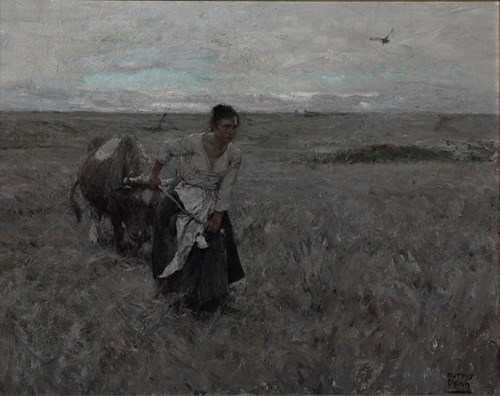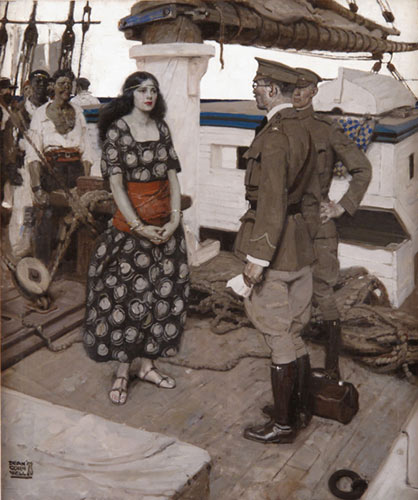The first major exhibition celebrating the art and legacy of one of America’s greatest illustrators is on view in South Dakota. Will it travel to your city next?
In connection with The Norman Rockwell Museum, the South Dakota Art Museum is thrilled to have available a comprehensive exhibition featuring the art of Harvey Dunn (1884–1954). Dunn, a protege of legendary artist Howard Pyle, is renowned for his illustrations depicting the great plains of America’s Midwest, and his works were regularly reproduced in such magazines as Collier’s Weekly, Harper’s Magazine, The Saturday Evening Post, and Scribner’s. The South Dakota Art Museum houses the most extensive collection of Dunn’s work, but has never organized such a thorough exhibition. Exceptional examples of Dunn’s most recognizable art for publication are featured in the exhibition, “which also highlights the artist’s powerful work for the American Expeditionary Forces, recording the unforgettable realities of combat.”

Harvey Dunn, “Homesteader’s Wife,” 1916, oil on canvas, (c) South Dakota Art Museum
In addition to being a prolific illustrator, Dunn was a visionary educator. With fellow artist Charles S. Chapman, Dunn founded the Leonia School of Illustration. Dunn would also go on to teach at the Grand Central School of Art, Pratt Institute, and the Art Students League, inspiring many of the 20th century’s most influential visual communicators. Indeed, Dunn once stated, “The most fruitful and worthwhile thing I have ever done has been to teach.”

Harold Von Schmidt, “Forgiven,” 1926, oil on canvas, (c) Collection of The Illustrated Gallery
In addition to masterpieces by Dunn, the exhibition features the work of some of his greatest students, including A. Allen, Harry Beckhoff, Mac Conner, Mario Cooper, Walt S. Louderback, Arthur Sarnoff, Harold Von Schmidt, and Saul Tepper.

Dean Cornwell, “‘Ah!’ said Tamea, ‘You do not believe, then, that I am the Queen of Riva?’,” 1923, oil on canvas,
35 1/2 x 20 in. (c) Collection of The Illustrated Gallery
A beautiful example from the exhibition is Dunn’s “After School” of 1950. The painting, clearly rooted in the expressive and loose brushwork of the Impressionists, shows a boy in overalls and cap following a blond-haired girl as they depart a distant schoolhouse. The strong prairie winds from left to right have encouraged the two figures to tread diligently and carefully. So lovely is the fact that Dunn’s brushstrokes almost exclusively follow this left-to-right directionality, enhancing one’s perception and experience of the winds. A barbed-wire fence moves from the left edge to the foreground as well, giving one the sense of the larger space and landscape that lay beyond the picture’s borders. Dunn’s palette is equally stunning, with a wide arrangement of pastel blues, reds, yellows, pinks, whites, and oranges. The overall experience is delightful from either distance or up close.
Titled “Masters of the Golden Age: Harvey Dunn and His Students,” the exhibition will hang at the South Dakota Art Museum through September 11 before traveling to the Norman Rockwell Museum in November. The last stop will be next June at the Hunter Museum of American Art in Chattanooga, Tennessee.
To learn more, visit the South Dakota Art Museum or this catalogue.
This article was featured in Fine Art Today, a weekly e-newsletter from Fine Art Connoisseur magazine. To start receiving Fine Art Today for free, click here.








